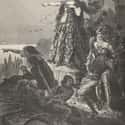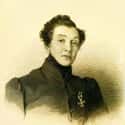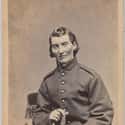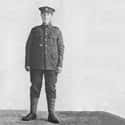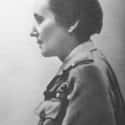-
(#1) Joanna, Countess of Flanders And Warrior In The Hundred Years War
She may have inspired Joan of Arc. Whether this is true or not, Joanna of Flanders, who was born in 1295, fought for France at the beginning of the Hundred Years War with England.
To demonstrate her military prowess, the politically savvy Joanna took advantage of factional infighting in France to stake her son's claim to the French throne. With France divided, she sent for help from the English King Edward III to aid her efforts in ensuring that her son, John, would eventually lead the Monfort faction and ascend to the kingship. In this way, Joanna was also able to avenge her husband, John, who had been imprisoned by Philip IV.
Throughout the ongoing series of wars, Joanna displayed her leadership qualities, which helped legitimize her son’s succession. During one of her many daring acts, Joanna dressed as a man in uniform, collected 300 French soldiers, and went up against the military camp of Charles de Blois who had besieged Hennebont. Joanna and her soldiers rampaged through the camp, burned supplies, and quickly rode away on horseback during this daring feat.
Joanna survived the war and her faction, the Monforts, eventually were victorious. Her life ended in England in 1374.
-
(#2) Brita Olofsdotter, The Woman Who Defended Narva From Ivan The Terrible
The Livonian War, a skirmish for control over what would become modern Estonia, was fought between the Tsardom of Russia, during the reign of Ivan the Terrible, and a Polish-Lithuanian-Swedish alliance. Though she had lost her husband who was also a soldier, Brita Olofsdotter of Finland disguised herself and fought for Sweden as a cavalry soldier.
At the 1558 Siege of Narva, she fought valiantly but did not survive the battle. Though the Russian forces briefly captured Narva, it was later retaken by Swedish forces. Once her true identity was discovered, King John III of Sweden made sure Olofsdotter's remaining earnings were paid to her family.
-
(#3) Christian 'Kit' Cavanaugh, The Career Dragoon
Sometimes known as ‘Kit’, Christian Cavanaugh was an Irish woman who served in the British army during the early 18th century. She was born in 1667 during the tumultuous post-Cromwellian years, and her remarkable story has elements found in many contemporary dramas.
Described as a wild child, Kit eventually settled down and married Richard Welsh, and they ran a pub together. In the 1690s, Richard disappeared, and it was believed he had been impressed into the British army and sent to the Netherlands. To find and bring her husband back, Kit left their children with her family, disguised herself as a soldier, and enlisted in the infantry of the British army to find Richard.
Her adventures led her to fight in several battles of the Nine Years War, during which time she was hurt and taken prisoner. After her return, she re-enlisted in the Royal-Scots Dragoons and continued searching for Richard. As a dragoon, she traveled on horseback and fought on foot. It is also believed she enjoyed plundering after battles. During the campaign in the Netherlands, Kit managed to find Richard — with another woman. Kit told Richard off rather than reuniting and continued to serve in the military.
During the War of Spanish Succession, Kit sustained a skull fracture while recovering from being shot in her thigh. While being treated, she was discovered to be a woman. She was treated fairly and upon her return to England, she was given a pension and a bounty. After her life ended, she was buried with military honors.
-
(#4) Hannah Snell, The Earliest Known Female Royal Marine
The UK's Royal Marines hold a status similar to that of the Marine Corps in the United States, and their history is no less colorful. Enter Hannah Snell, the earliest known Royal Marine.
Snell was born in 1729, in Worcester, England, and she got married as a young woman. In a similar turn of events to that of Kit Cavanaugh, Hannah’s husband, James Summs, also went missing, and to find him, Hannah disguised herself and enlisted in the army. In Hannah’s case, however, she took her brother-in-law’s name to go undercover. She later discovered that James had been convicted and hanged for ending others' lives.
Undeterred, Hannah continued serving and enlisted in the Marines. She soon found herself on many adventures across the world eventually leading to fighting in India. During the campaign, Hannah was seriously hurt a total of twelve times, including a musket shot to the pelvis. It is believed she operated on herself to avoid her identity being discovered by a surgeon.
In the 1750s, she left the military and returned to England. It was at this point in her life that she decided to let her identity be known to her fellow Marines. As with Kit Cavanaugh, her identity wasn’t met with ire, but rather with praise and support. She even managed to receive a pension and was honorably discharged from the Royal Marines.
For the rest of her life, she owned a pub and remarried several times. She also raised two children. Hannah Snell perished in 1791.
-
(#5) Anna Maria Lane, The Woman Who Fought In The American Revolution
The American Revolution was a struggle in which the budding United States needed all the help it could muster to gain independence from the British Empire. Every individual and decision played a significant role.
While it has been common for women to work for the military throughout American history, it was unheard of for women to openly serve in the ranks. But for Anna Maria Lane, this became a reality when she went to war dressed as a soldier and undercover as a man.
Believed to be from the New England state of New Hampshire, Anna and her husband traveled with the Continental army when a battle broke out with Britain. The Lanes both served with distinction, particularly at the engagement of Germantown in Pennsylvania. It was there that Anna Maria was hurt. Both Anna and her husband, John Lane, survived the revolution and settled in the new state of Virginia.
Like Kit Cavanaugh and Hannah Snell, Anna Maria also revealed her true identity and was awarded for her service with a pension and reverence. Her life ended in June 1810.
-
(#6) Deborah Sampson, A Party To The Siege Of Yorktown
She went by the nom-de-guerre, Robert Shurtlieff, but her real name was Deborah Sampson, and she went on to see the birth of the United States of America.
Sampson was born to a poor family near Plymouth on the southeastern coast of Massachusetts in 1760. She was adopted at a young age, and, while teaching herself to read and write, she was taken in by a Deacon and his family. Before the Revolution, she was an indentured servant, a school teacher, and a weaver, depending on the season. It was around this time in her life that Deborah became interested in soldiering. It is believed that she cautiously tried out wearing a uniform before entering the service.
After realizing she could get away with it, Deborah enlisted as a man in 1781 and arrived at West Point in New York to receive her uniform. She first served in a scouting party and eventually went with the army to take part in the Siege of Yorktown where she sustained injuries. As with Hanna Snell decades earlier, Deborah treated herself and survived without infection. Once healed, she returned to active military service.
After the Revolution, Deborah was honorably discharged from the Continental Army and returned to Massachusetts where she married and gave birth to three children. After her passing in 1827, her family was granted a pension. It was also noted by pension officials that the American revolution, “furnished no other similar example of female heroism, fidelity, and courage.”
-
(#7) Joanna Zubr, The Napoleonic Warrior
Very little information survives about the life and times of Joanna Zubr (sometimes listed as Zubrowa), but there is enough to understand who she was.
Born in Poland just a few years before the American Revolution, Joanna was a young woman when she and her husband, Michal, enlisted in the forces of the Duchy of Warsaw, a section of the Napoleon Bonaparte’s Grande Armee. Disguised as a man, Joanna served in the infantry.
Following the battle of Zamosc, Joanna was promoted to the equivalent rank of sergeant for her service during the battle. She was also awarded Poland’s highest military medal, the Virtuti Militari.
After the series of conflicts ended, none of which Napoleon actually started, Joanna and Michel moved to the city of Wielun where they lived for the rest of their lives. Joanna lived until she was 80, uncommon for the time, living until the early 1850s.
-
(#8) Nadezhda Durova, A Fighter In The Tsar's Cavalry
History is often filled with strange, uncanny coincidences. While Joanna Zubrowa was campaigning at Zamosc Fortress, it is possible that at one point or another she crossed paths with Nadezhda Durova, a Russian cavalry trooper fighting for the Tsar. While unlikely, she may have even been the soldier to unknowingly hurt Joanna Zubrowa.
Nadezhda, who was of Ukrainian descent, was born in September 1793 in the Russian empire to an adoring father and a loveless mother. At an early age, sages would likely say that Nadezhda was destined to be a soldier.
One story involves Nadezhda’s mother throwing her out of a carriage while accompanying her husband on a military campaign. This act was said to reduce battle-hardened veterans to tears. Miraculously, Nadezhda survived and was cared for by her father and his fellow soldiers.
While a young woman, she left her newly wedded husband and enlisted, as a man named Aleksandr, in the Polish Lancers during the Napoleonic Wars. She was noted for displaying extraordinary courage, sans-judgment and never revealed her true identity. By 1816, she had achieved the rank of captain. After retiring from the military, Nadezhda returned home to help her father. Restless with civilian life, she began to write and penned her memoirs, later published as Cavalry Maiden.
Her life ended at the age of 86 in the mid-19th century and was buried with full military honors.
-
(#9) Frances Clayton, A Member Of The Union Army Cavalry
Experts believe that hundreds of women actually served in combat roles during the American Civil War. When the first guns fired on Fort Sumter and thousands rushed to the colors in 1861, among them was Frances Clayton, who would become known as Jack Williams. A native of Illinois and in her 30s at the time, Frances and her husband, Elmer Clayton, had three children and were living on a farm in Minnesota.
Once the war erupted, Frances and her husband enlisted together — with Frances in disguise — in the Union Army. Both served honorably, but Frances displayed great courage in as many as 17 combat engagements. She kept up her disguise and bravery even when her husband perished in front of her at the battle of Stones River in 1862.
Frances too was soon hurt, possibly at the hip, which may have helped bring light to her true identity. This, however, is not certain as very little information about her wounds and post-war life exist. She survived the war, but her whereabouts and the fate of her children is not known.
-
(#10) Cathay Williams, The First African American Woman In The United States Army
The American Civil War was far more complicated than the simple divisions we have come to associate with it, like "North vs. South" or "Blue vs. Grey." In both the Union and Confederate armies, many regiments were made up of foreign nationals and ethnic groups from across the world. The story of Cathay Williams, known to her fellow soldiers as William Cathay, however, may be among the most unique.
Born a slave in Missouri, Cathay’s father was a free man while her mother was still in bondage as property of a slave owner. In 1861, Cathay was impressed into the Union army as a cook and a washerwoman. By 1864, she had worked for Union General Philip Sheridan and traveled with the army into the western theater.
In 1866 after the war ended, Cathay managed to disguise herself, adopting the name William Cathay and enlisted in the army until 1868 when her identity was discovered. For several years, she served in the New Mexico territory at several barrack outposts.
As her story progressed after her discovery, less and less information is recorded about her. She moved further west and applied for a pension, still under the name of William Cathay, as late as 1891. After this year, her whereabouts and fate are unknown. To date, she is the only known African American woman to serve in the Union army during the 1860s.
-
(#11) Loreta Janeta Velazquez, The Female Member Of The Confederate Army
As with Cathay Williams, Loreta Janeta Velazquez — another female fighter in the conflict between the Union and the Confederacy — found herself in a wildly complex situation. Velazquez was born in Cuba in 1842, and when she was around seven she was sent to receive an education in New Orleans. At the age of 14, she married a Texas militia officer who soon went to war when Texas and the other southern states left the American Union.
Loreta didn’t want to be separated from her husband, and despite his firm opposition to letting her join him, she paid for a military uniform made to fit her perfectly. Then, the young woman donned fake facial hair and took on the name of Harry T. Buford. She proceeded to follow her husband to Florida where he was serving.
Going as far as to fake a military rank of Lieutenant, Loreta first traveled to Arkansas to assemble a regiment. Soon, she and her soldiers continued on to Florida where she found her husband. Loreta’s husband was felled in an accident soon after she arrived. After her husband’s death, Loreta led a successful military life with several occupations. She served in various regiments, jumping back and forth between her character of Lt. Buford, and then as herself acting as a spy for the Confederacy, and then as a low-ranking soldier.
During the post-war years, she remarried a for a third time, moved to Venezuela, lost her husband, returned to the United States, and gave birth to a child. Realizing that a life as a man and being constantly on the road had to soon end, she decided that if she published her memoirs and revealed her identity, she would be able to use the money from her book to support herself and her son. in 1876, The Woman in Battle, was published.
Less is known about the final years of her life and she is commonly believed to have lived until the late 1890s.
-
(#12) Dorothy Lawrence, The Only Known British Woman To Fight In WWI
Dorothy Lawrence’s tenacity helped her embark on the adventure of a lifetime and into the annals of history. More than a hundred years later, her story survives because of how uncommon and tragic it was.
The facts and details of Dorothy’s early life often contradict each other, but what can be strung together is that she was born in Hendon in the 1890s to an unmarried mother and was soon given up for adoption. Later in life, Dorothy would claim that her guardian, an official of the Church of England, had assaulted her while in his care.
Before WWI, Dorothy wanted to become a journalist, and, at the outbreak of war, bicycled through France keeping close to the English army to try to prove herself as a front-line correspondent. At every corner, she was met with discrimination and frustration.
Then, in 1915, she decided that to produce a raw and thorough story as a reporter: a first-hand account of WWI. Soon, at a cafe in Paris, Dorothy convinced two British Tommies on leave to help her. Leaving no stone unturned, Dorothy had several soldiers smuggle her a uniform and equipment kit piece by piece until she could slip into the ranks unnoticed.
Once in France, one of the soldiers managed to find an abandoned farm house for Dorothy to sleep in while bringing her food and other items. Then, with great risk to all involved, Dorothy was smuggled into the 179th Tunneling Company of the Royal Engineers to construct vast, subterranean mines under the German trenches. Each mine was filled with explosives and detonated. The backbreaking work took its toll on Dorothy and she became very ill in the dangerous conditions. She then turned herself in and was temporarily imprisoned.
After WWI, Dorothy suffered ridicule, rejection and financial difficulties. She was then committed to a mental institution until her death in the 1960s.
-
(#13) Wanda Gertz, The Woman Who Fought In Three Wars
Wanda Gertz was a titan among women who witnessed, experienced, and played a part in 20-century history. Born in 1896, Gertz began life in Warsaw, Poland, in a family of Saxon heritage. In 1914, Wanda was part of a nationalist independence organization, Konfederacji Polskiej (KP) and helped equip the Warsaw Battalion to fight in WWI. At the time, women were barred from serving, but this didn’t discourage Wanda, and she decided to disguise herself as a man by the name of Kazimierz Żuchowicz.
Soon, Wanda saw combat on the eastern front of WWI in conflicts against the Imperial Russian Army. While campaigning, she developed technical skills from working on railways, using horses to move equipment and how to operate artillery cannon.
In the chaos of post-WWI Eastern Europe, Wanda returned to active service still as Kazimierz. The newly formed RKKA, the Red Army of the Soviet Union, began marching west from Russia to spread communism and their attack included overrunning Poland to establish a communist government. During this period, known as the Polish-Soviet War, she rose to the rank of commander and led the Second Women’s Volunteer Legion stationed in Vilnius.
The Polish Victory against the Soviets at Warsaw in 1920 resulted with Wanda being awarded the Virtuti Militaria. Poland’s newly established independence was a lull in military service for Wanda, but not by any means the end of active service.
Only 19 years later, with the Molotov-Ribbentrop Pact and the Soviet-Nazi invasion of Poland, Wanda Gertz returned to serve Poland with a new alias, ‘Lena.' From 1939 to 1944, Wanda, now as Lena, worked for the Polish Government in Exile and the SZP (Sluzba Zwyciestwu Polski) spy organization. Through WWI she expertly impeded the efforts of German military forces, the Abwehr and other spies. She was captured and briefly interned until 1945 when allied forces began liberating concentration camps.
Wanda’s leadership helped her fight three wars, oppose, resist, and see the end of the Third Reich in Germany and outlive both Joseph Stalin and Adolph Hitler. Her service to help those who ultimately would survive WWII is often overlooked. She lived until in 1958.
New Random Displays Display All By Ranking
About This Tool
In history, this society was full of regulations and opinions that could restrict and prevent women from living the way they wanted. Many female writers have adopted male pen names, and some women have even changed their appearances and names to get a more free and comfortable life. Pretending to be a man is a way of accomplishing things they could not otherwise. Even like Eowyn in "Lord of the Rings", a small number of brave women in history dressed as men and fought in the wars.
The random tool introduced 13 brave women who disguised themselves as male soldiers to fight in wars, some of them pretend for a short time, and in a few cases, their biological gender was only discovered after they die.
Our data comes from Ranker, If you want to participate in the ranking of items displayed on this page, please click here.











